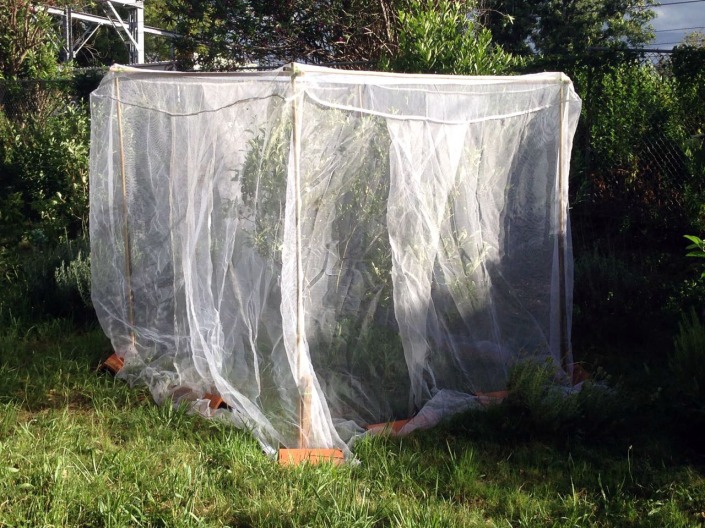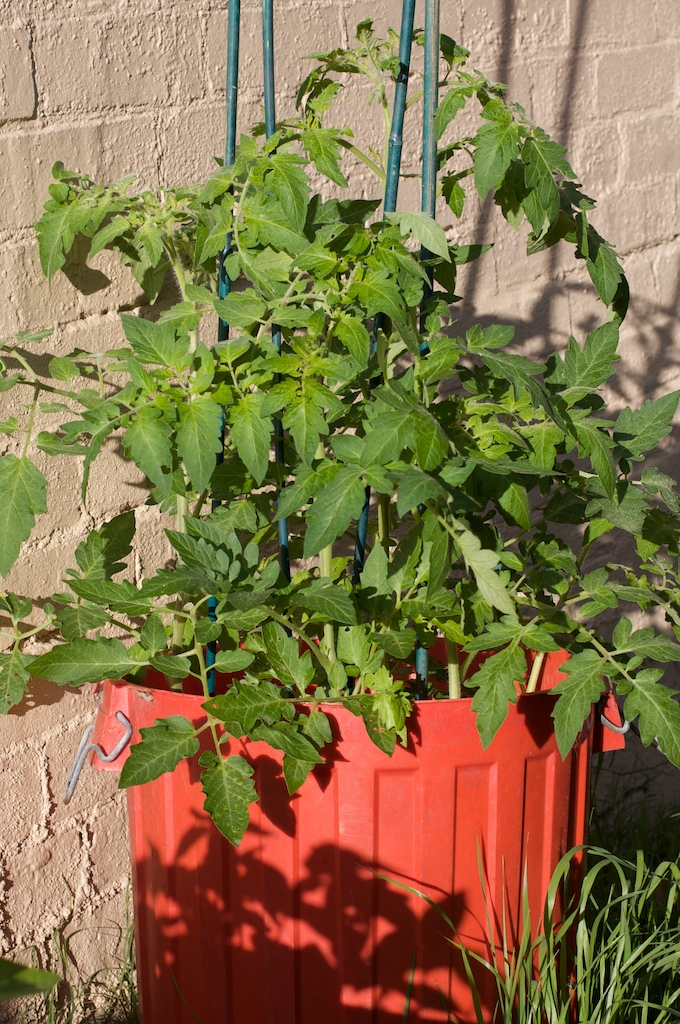tomatoes
Making things with bamboo

As part of a book order last year, I picked up a copy of Bamboo Rediscovered by Victor Cusack. This wonderful book draws on decades of experience to show that bamboo doesn’t have to be an invasive monster, and that bamboo poles are tremendously useful, in the garden and elsewhere.
So when it came to protecting our apple harvest against fruit flies and other pests, I turned to bamboo. I sourced a bunch of 3m long poles from All Stakes Supply, who had them delivered to me in just a few days.
Now, how do I actually tie bamboo stakes together into useful structures? Youtube to the rescue, with several handy tutorials on tying square knots. These are the instructions I ended up following:
The first use was to create a support structure for my tomatoes. (It’s enormously high, by the way, so I didn’t have to cut the bamboo poles, thus retaining them for later uses.)

I also created box frames around my key apple trees, covered by insect netting. The result is rather impressive looking, I think.

Full disclosure: my knot skills are still pretty patchy, so some of the frames held up, and others slowly slipped apart. Practice makes perfect!
I now have a good collection of robust bamboo poles, which should last many years, and be useful for a dozen different projects.
(Inspired by the book, I also planted out a number of clumping bamboo varieties in the land behind our house. These should grow to give us better screening from the railway line, and I’ll blog about them at a later date.)
Summer crop of pickles and chutneys

It’s been a hot summer in Sydney, with some much-needed rain after an extended dry period. So as usual, the summer glut of produce overwhelmed our immediate needs.
One of my favourite activities is converting what we grow into jars of pickles, chutneys and the like. This is what we produced this summer:
- Australia Day chutney
- cucumber relish (two ways)
- pickled beetroot
- pickled bur gherkins
- pickled cherries (two ways)
- tomato chilli pickle
- tomato & onion relish
- tomato passata
- tomato & tamarind chutney
By my count, that’s 42 jars, not including the half-dozen we’ve already given away or used. That’s not bad considering that half of our main raised beds were attacked by roots, and therefore struggling to produce anything…
Warrigal greens pizza

Warrigal greens, native to Australia and New Zealand, grows vigorously in Sydney. While in theory it’s an annual, it self-seeds so vigorously that once you have one plant, you have a steady supply forever.
On more than one occasion it’s kept us going when we haven’t had any other greens growing, such as spinach or kale. It can be used just like spinach, with the proviso that warrigal greens must be cooked for at least 3mins (it’s high in oxalic acid — which is toxic — and the cooking breaks that down to make it safe).
This is the first of a number of recipes we’ll be posting that combine traditional seasonal ingredients with native elements…
Warrigal greens pizza

800-900g of ripe tomatoes (any varieties as long as they’re fresh from the garden)
250g of warrigal greens (leaves and young shoots)
handful of fresh basil leaves
1 clove of garlic
half a red onion
100g of mozzarella or pizza cheese mix
pizza base (home-made or store-bought)
Making the pizza sauce:
- Start by adding some olive oil to a saucepan over a medium heat.
- Cut the fresh tomatoes roughly into pieces and add to the saucepan.
- Cook until the tomatoes break down into a rough sauce, helping the process by squashing the tomatoes with a potato masher or heavy spoon. This will take 10-15 mins depending on the varieties of tomatoes used.
- Cut the garlic into thin slices and add to the pan along with the basil leaves.
- Cook for 2-3 minutes, and then strain the sauce through a sieve. Press down on the mix with a wooden spoon to ensure as much sauce is kept as possible. (If you’ve got backyard chickens, they’ll adore the left-over tomato skins and seeds.)
- Add the strained sauce back into the pan, and cook for 20-25mins to reduce to a thicker consistency (it will still be quite thin, but that’s OK).
Making the pizza:
- Meanwhile, set the the oven to its highest setting, and place a pizza tray in to pre-heat.
- Bring a large pan of water to the boil, and add the warrigal greens.
- Cook for 3 minutes, and then pour out into a strainer. Wash with cold water, and then squeeze the moisture out.
- Thinly slice half a red onion.
- Cover the pizza base with the fresh tomato sauce, and some of the cheese.
- Scatter generously with the warrigal greens, and top with the sliced onion.
- Add a little flaked salt, and then cover with the remaining cheese.
- Put into the oven, and cook until golden brown.
It’s a super-simple recipe, and the warrigal greens are just like spinach but with a rounder flavour. If you have picky eaters, don’t tell them it isn’t spinach, and they’ll never know!
We’re back into tomato season

With the hot weather in Sydney, we’re well and truly back into summer tomato season.
We’ve got a wide variety of tomatoes growing, large, small, red and yellow. These are just a few, picked early to ripen in our kitchen away from the pests.
Most meals now include some tomato, and we’ve started bottling and pickling like mad.
Hand-sized “Mortgage Lifter” tomatoes

This hasn’t been a great summer season for the garden. The lack of sun and constant rain has meant that many seeds haven’t germinated properly, plants have grown up stunted, and yields are way down on last year.
Still, you can’t go past these two beauties! I can see why they’re they’re the “Mortgage Lifter” variety, each one big enough to feed a small family.
Even in coldest summer in 11 years (or 40, depending on who you listen to), we’ve still got more tomatoes than we can eat. So the canning equipment has come out, for a dozen jars of various chutneys, relishes, etc. Definitely better than nothing!
Saving our tomatoes

The warm, wet weather has meant a glut of tomatoes this summer. We’ve also had few fruit fly (although an invasion of moths and caterpillars). The result has been dozens of kilos of tomatoes, far more than we can eat.
This was, however, the plan. With the bounty of tomatoes, I filled many jars. The photo above is what’s left, after giving quite a lot of it away.
By my rough count, this is what we produced:
- 13 x roast tomato pasatta
- 8 x cherry tomato & onion relish
- 5 x tomato chilli pickle
- 1 x tomato ketchup
- 1 x semi-dried tomato
Plus tomato soup, pasta sauce, and a dozen other recipes using fresh tomatoes. Oh, and I took piles into work to give to my staff…
Not bad out of 7 square metres of space (plus the jungle at the back).
Heirloom tomatoes

At this time of year, the tomato crop is in full swing, and the great thing about planting heirloom tomatoes is the variety. At any given point, our fruit bowl is full of ripening tomatoes, red and yellow, small and large. We pluck them off the plants as soon as they start to colour up, to reduce the crop losses to caterpillars. It doesn’t take long for them to ripen properly, and then into our cooking…
In addition to eating them fresh, we’ve also been storing them for future use, via bottles of:
- roast tomato passata
- tomato ketchup
- cherry tomato & onion relish
A jungle of tomatoes

The wet spring (the wettest on record) has been miserable for us humans, but the garden has been loving it. Plants that did well last year have gone crazy this year, beyond all reasonable expectation.
This includes:
- Tomato plants (both bush-type and climbing-type) that have gone wild, taking over everything.
- Beans and snowpeas producing vigorously.
- Celery sprouting everywhere, after I let a single plant go to seed last year.
- Sweetcorn that’s higher that us.
- Cucumber plants starting to get out of control.
Now we’ve just got to stop it all getting eaten by caterpillars, and keep on top of our harvesting and eating …
The tomato harvest

We’ve had a reasonable first year for tomatoes. Plenty of fruit, but we were hit hard by fruit fly and caterpillars (who decided they preferred eating the fruit from the inside out, rather than just munching on leaves). This wiped out most of the Grosse Lisse (the first to fruit), and half of all the rest. In the end, it was the yellow tomatoes that were the star, juicy and even sweeter than the red variety.

Once we’d eaten them fresh, there was still 5-6kg of tomatoes left over. Having collected four different preserving books, I created:
- Roast tomato passata (orange and yellow, referring to the colour not the taste)
- Tomato ketchup (superb, a real crowd pleaser!)
- Tomato chilli pickle (also a winner, wonderfully fruity flavour)
I’ve cut back the plants, and hold out some hope for a second crop of fruit. We’ll see.
Many lessons learnt this year, including putting out the fruit fly baits from the outset. Next year I’m aiming for at least 10kg of tomatoes.
Serendipity and tomatoes

We we moved, we had some left over soil and compost in an old garbage bin. I left this beside the side of the house, and thought nothing more of it.
Until tomato shoots starting poking their heads up. This is pretty normal: we have tomatoes appearing out of our compost at the drop of a hat. This was a particularly good effort though, growing in a bin whose contents are in permanent shade, coming into winter.
Apparently no-one told these tomatoes that they’re out of season. So I thought I’d help them along with some garden stakes, and I’m wonding what kind of tomatoes they’ll turn out to be…